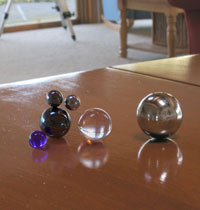 |
|
This is the probe that records all the light in our dining room. The image is made by combining a wide range of exposures. Most computer images can only hold 256 levels of brightness. By combining bracketed photos into one, it can have brightness values ranging from the sky (10,000 cd/m2) to the shadows under a couch (3 cd/m2) |
 |
|
Radiance is a free program that renders light very accurately and uses real world units (candelas per sqaure meter) instead of arbitrary values. With code developed by Paul Debevec, one can unwrap the image from the probe and project it onto a box that glows with the values taken from the photo. Thus the CG light will match the real light. This is a photo with a real ball on the right and CG balls on the left |
 |
|
This image was rendered from light recovered on a slightly overcast day in Corvallis, Oregon. The hulk model was created by William Freeman with Hash Animation Master - exported as an obj and converteed to a Radiance Mesh object. Notice the diffused shadow at the hulk's feet. This matches the shadow and light direction of the photo. I gave hi skin a slight specular value to show the reflections from the lighting environment. |
 |
|
This is the overcast probe. Keep in mind this is a jpeg, not the HDR image used for the light. This jpeg only contains a 24 bit (256 values) rendition of the light. The source HDR probe has values ranging from 40,000 to 66 |







